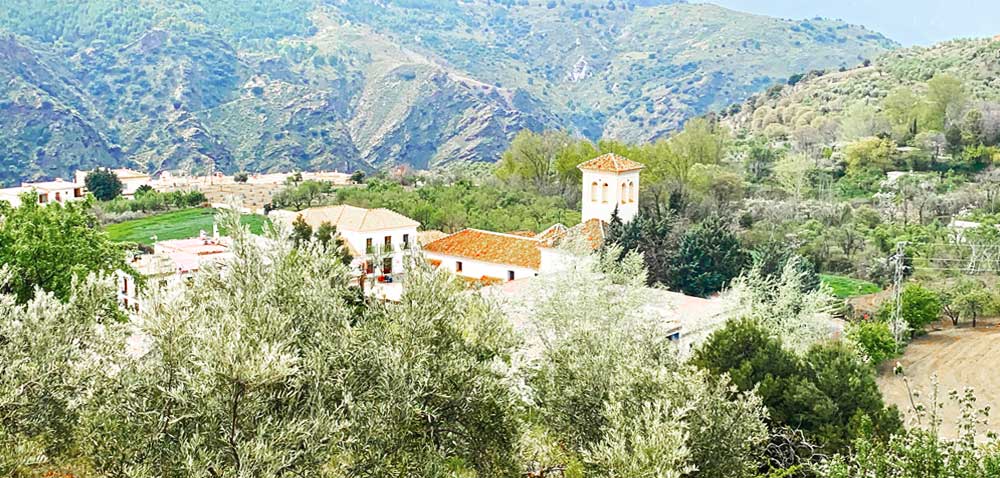La Taha & The Medieval Route
La Taha, Off the Beaten Track in the Alpujarras...
If Andalucian charm and authenticity is what you crave... La Taha has it in spades. We challenge you to find a land more pure and untouched as this magical place deep within the rolling hills of the Alpujarras.
Inherited by the Arabs more than 800 years ago, most of La Taha’s customs, architecture, and basic ways of life have not changed much over the years... A visit to this area will take you back to a simpler time when nature and quiet solitude prevailed.
Check out the other Alpujarra villages: Lanjarón - Órgiva - Capileira - Bubión - Pampaneira - Pitres - Trevélez
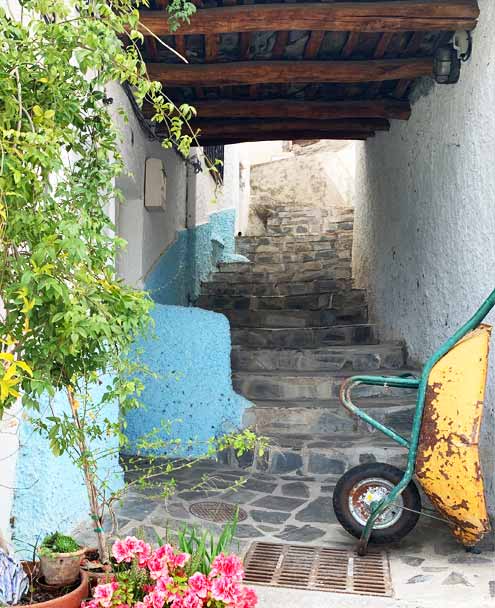
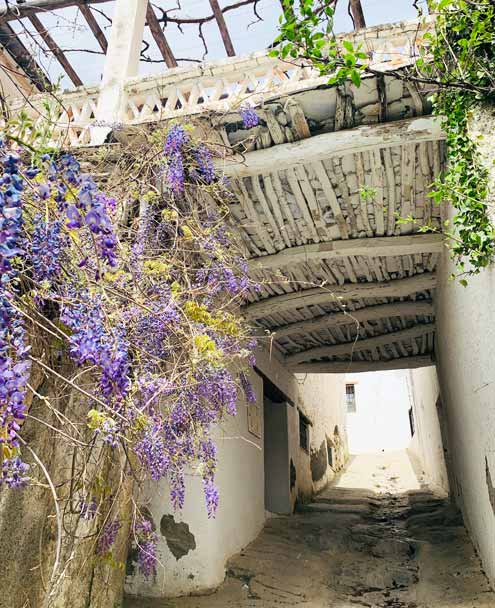
** Brightly colored tinaos in the La Taha villages.
Close your eyes and imagine a land unspoiled by modern tourism. A string of ancient villages that remain today as they always have been. Picture their white washed streets and alleys overflowing with brightly colored Geranaiums and Wisteria... all surrounded by thousands of olive and chestnut trees.
In the springtime this land comes alive. Take a stroll on the old Mediveal path that connects these timeless towns along gushing irrigation canals and past roman bridges, mills, and waterfalls. The fragrance and color of the La Taha countryside will remain forever in your heart.
Why Visit La Taha? Take some time and get back to nature! Leave the bustling towns of the Poquiera Gorge behind you and enjoy some hiking, cycling, or horseback riding in this special place.
Contents on This Page
- The Villages of La Taha
- What is the Meaning of La Taha?
- Where is the 'La Taha' Region?
- Where to Stay in La Taha?
- What to Do in La Taha?
- Visit the Quaint Villages of La Taha
- Visit the Top Sites in La Taha
- Rural Alpujarran Cuisine - Where to Eat!
- Join a Tour to La Taha
- Hiking in La Taha! - The Medieval Route
- Biking in La Taha - Where to Rent
- The Tourist Office
- When to Visit La Taha
- How to Arrive
- A Brief History of La Taha
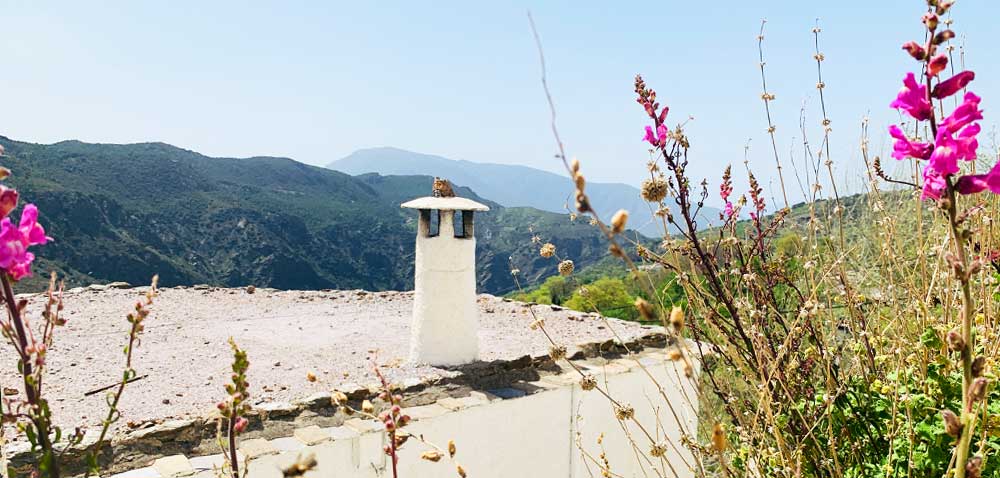


** (1) The houses in La Taha with their characteristic flat roofs and chimneys (2-3) Pretty streets and tinaos.
The Villages of La Taha
Welcome to the REAL Alpujarra, an area where few people get the opportunity to explore. Inhabited by fewer than 700 residents, the area of La Taha consists of 8 unique villages. Although some of these villages make up larger municipalities.
- The capital of La Taha is Pitres, it's the largest of the eight towns and has the majority of the regions
inhabitants, roughly 500 of the 700 total number of residents.
- Mecina Fondales is the second largest municipality which is made up of three smaller towns;
Fondales, Mecina, and Mecinilla.
- The third largest settlement is Ferreirola, which is southeast of Mecina Fondales.
- Lastly are the two tiny villages of Atalbéitar and Capilerilla.
- One last village of note is Aylácar, which has zero inhabitants and is known as the abondoned village of La Taha.
What is the Meaning of La Taha?
The origins of the name "La Taha" are very interesting. Like we mentioned earlier, this entire area was once under Moorish rule by the Nasrid King of Granada. He broke up the areas around Granada into small administrative districts called "Tahas".The word "Taha" comes from the original Hispanic-Arabic word Tá, which meant “obedience”. These individual districts or Tahas were meant to be obedient and to answer only to the king.
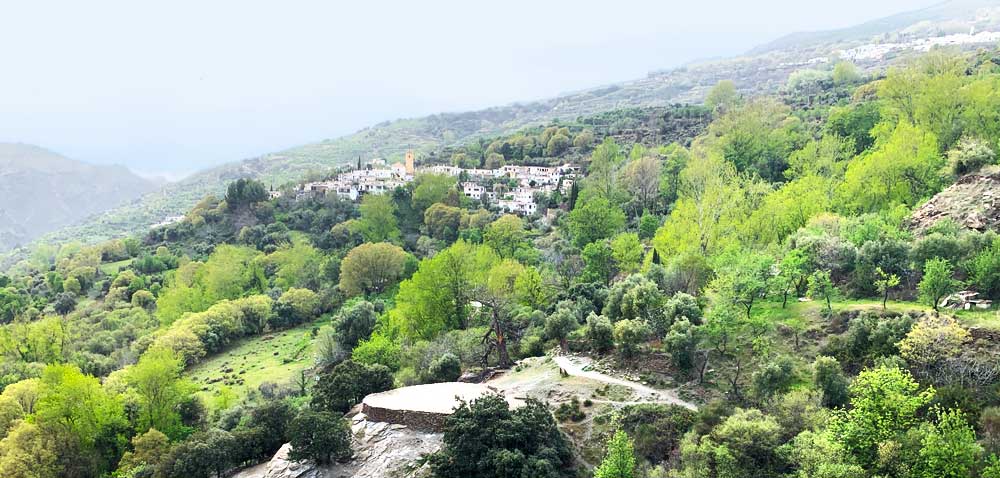
** Hiking the Medieval Route with the La Taha villages (Fondales / Mecina) in the distance.
There were several Tahas in the Alpujarras, the Poqueira Gorge area was known as La Taha de Poqueira and the Pitres area was known as La Taha de Ferreyra (from an earlier iteration of Ferreirola). As time went on the area was renamed to La Taha de Pitres (after its new capital).
After the Moors were defeated in Granada and expelled from Spain, the administrative areas were renamed and the ‘La Taha’ prefix was dropped in every area except in La Taha de Pitres… as it is still known today.
Where is La Taha?
Driving up into the Alpujarras, just south of the capital city of Granada, you will find the isolated villages of La Taha.It lies just past the more populated and highly visited towns of the Poqueira Gorge (Pampaneira, Bubion, and Capileira) and just south of the highest town in mainland Spain, Trevélez.

The La Taha villages can all be found within the borders of the Sierra Nevada National Park, between the Barranco de Bermejo and the Barranco de la Sangre. They cling to the hillsides, facing south towards the shimmering Mediterrenean Sea. Both the rivers Trevélez and Guadalfeo meander through the valley below.
Where to Stay in La Taha
Although this is a rural area, accomodations are plentiful. There are several rural hotels offering apartments and cottages and you will also find a nice selection of Berber homes to rent.There is also the Pitres campground offering areas to pitch a tent or rent bungalows.
Also check out the nearby town of Capileira during the high season, as it has the largest selection in the area. Places to stay in Capileira.
Our three top recommendations in La Taha are:



Rent a Pretty Cottage or Berber Home

Trusted Booking / VRBO Partner
What to Do in La Taha?
If you are looking for high-end shopping and modern art exhibitions you're not going to find it here. La Taha is a place of sleepy villages, rural ermitas, roman bridges, and wonderful hiking trails. Take some time to wander through its towns, enjoy a well cooked meal, and visit some of the more "off the beaten track" sites below.1. Get Lost in the Winding Streets and Alleys of the eight Villages of La Taha
The La Taha villages are all just a short distance from one another and you could easily see them all in day. We suggest visiting the capital city of Pitres first and from there you can set off along the Medieval Route to see the other towns on foot.


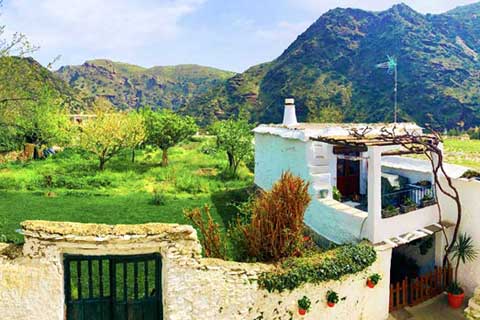

2. Visit the Top Sites in La Taha
The top places to see while you're in the area of La Taha are:
- The Royal Roads or Escarihuelas - This is where all the action happens! The Liberty Plaza is in the center of La Taha and where you will find all the best shops, restaurants, cafes and more...
- The Roman Bridge of Fondales - This is La Taha's main church that sits at the center of Liberty Plaza. It dates to the 16th century and was built in the Mudéjar style. The interior boasts a wooden coffered ceiling and gilded altarpieces dating to the 17th and 18th centuries.


** The Church of Santa Cruz in La Taha's main square and one of the many artisan shops.
- Fuente Agria & El Chorrerón - The Alpujarra area is known for its locally crafted textiles and pottery. You will find an abundance of brightly-colored blankets, rugs, and beautifully woven clothing. There are also numerous pottery boutiques and shops dedicated to other local crafts and homemade food products like jams, honey, wines, and cheeses.
- Ermita de la Virgen de las Angustias de Pitres - Chocolate is another delicacy the Alpujarras is known for, and you will find this fantastic chocolate shop right across from the Santa Cruz Church in Liberty Plaza.


** The "La Chumpaneira" fountain and the historic "lavandero" or laundry house.
- Aljibe de Campuzano - Directly across from the church you will find this interesting fountain. The plaque above it reads: "A source of virtue and powers such that when an unmarried man drinks from this fountain, he will marry without fail; he will instantly find a girlfriend. Try it and see!"
- Salto de Paula - Located just above the Plaza, overlooking the church, you will find the ancient town laundry house. The building is still in great condition and from there you will enjoy beautiful views of the town below.
- Chocolates Sierra Nevada - Directly across from the church you will find this interesting fountain. The plaque above it reads: "A source of virtue and powers such that when an unmarried man drinks from this fountain, he will marry without fail; he will instantly find a girlfriend. Try it and see!"
- Jardín de la Alpujarra - Located just above the Plaza, overlooking the church, you will find the ancient town laundry house. The building is still in great condition and from there you will enjoy beautiful views of the town below.
3. Join a Tour to La Taha
Most tours don't get as far into the Alpujarras as La Taha, this is what makes it so special. But there are numerous tours that visit the top nearby Alpujarra villages, and one that even drives through the La Taha area and stops in it's capital city, Pitres.While you're here, also take advantage of some of the outdoor activities that can be found nearby, like rafting, hiking, cycling, or even a Four-Wheel Drive Safari... See them all here.... Being in the middle of a national park, the Alpujarras is a very beautiful and natural area to explore.

Cuisine in La Taha - Where to Eat!
In La Taha, your going to find the same kind of fare that you would find in the other Alpujarra villages in the nearby Poqueira Gorge. Specialties include salty hams and sausages, "Patatas a lo Pobre" or Poor Man's Potatoes", migas, and other grilled meats and stews.If you are looking for something unique try "La Cueva de Mora Luna", it's run by an Argentinian family and has a wonderful, eclectic menu.
Our two favorite restaurants in La Taha are...


Hiking in La Taha! - The Walks
One of THE TOP activities in and around the village of La Taha is hiking and trekking! One of the best hiking trails is the Atalaya Trail that does a circuit around the gorge and goes through the three villages. We did this with our children and it was FABULOUS! The entire hike takes about 3 hours and 40 minutes and then we stopped in La Taha for lunch and shopping.
- The Atalaya Trail - For more information on this trail read our guide on the Atalaya Trail full-day hike.
- La Taha to Bubión - If you are looking for a shorter hike you can take the path that leads out of La Taha to the next village in the gorge, Bubión. The hike takes 20-minutes, but a warning... it is ALL uphill.
- Capileira to La Taha - This is probably the easiest hike and the one to choose if you want something quick and easy. It's all DOWNHILL. The entire hike will take about 40-minutes, 20-minutes between each town. You can take your time and tour the villages on your way. If you don't want to hike back up, taxis are available for the quick 5 km ride back to the top.

** La Taha Bridge and Waterfall in the Poqueira Gorge.
Tourist Office
NEVADENSIS / SIERRA NEVADA NATIONAL PARK
Address - Freedom Square, 18411 La Taha (Granada)
Tel: 958 763 127
MOUNTAIN ACTIVITIES AND TOURISM: 659 109 662 & 659 843 157
Website: www.nevadensis.com
Opening Hours:
Monday to Saturday: 10:00 – 14:00
Email address: guias@nevadensis.com
NEVADENSIS sells maps of all the local walks in the area and also specializes in a multitude of outdoor activities in the Alpujarras and the Sierra Nevada Ski area. They offer guided tours for walking/trekking, horseback riding, four-wheel-drive excursions, rock-climbing, and mountain biking.
Village Information
| Region: | Las Alpujarras |
| Post Code: | 18413 |
| # of inhabitants: | ~ 350 |
| Inhabitants: | Pampanurrios |
| Distance to Granada: | 68 km |
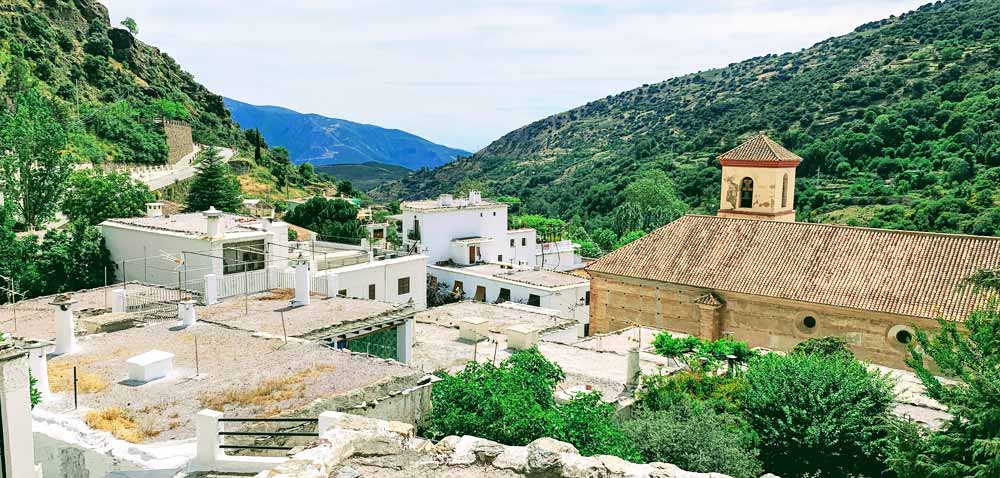
** The La Taha Church (Iglesia de Santa Cruz) and town from above.
Other Important Information About La Taha
1. La Taha has been Chosen as One of the "Prettiest Villages in Spain"!
La Taha, located in the Granada province, has been chosen by the Association of The Most Beautiful Villages in Spain as one of the most beautiful villages, the other being its neighbor to the north, Capileira.The other "most beautiful villages" nearby in Andalucia are Frigiliana (Málaga Province), Vejer de la Frontera, Grazalema, Zahara de la Sierra, and Setenil de las Bodegas (Cádiz Province).
2. La Taha Fiestas
The Autumn Fair (Feria de Artesanía, Turismo y Agricultura Ecológica) - On October 12th, La Taha holds a giant fair, the biggest in the area, where you will find a wonderful assortment of locally made Alupjarra products, including textiles (colorful rugs and blankets), crafts, soaps and candles, jellies and jams, jars of honey, Moorish pastries and more...The Chestnut Festival (Fiesta de la Mauraca) - On November 1st La Taha holds its famous chestnut festival (which also takes place in neighboring villages). It is celebrated by roasting chestnuts over an open fire, dancing, and singing traditional Alupjarra songs. The roasted chestnuts are later enjoyed with a warm anise-flavored liquor.
3. When to Visit La Taha
La Taha can get quite chilly in the winter being so high up in the mountains. So, the best time to take advantage of the great outdoors is spring and fall. The months of May and June are ideal for hiking as the entire gorge is in bloom with bright yellow scotch-broom and red poppies.
- During May and October, you are most likely to experience good weather with pleasant average temperatures that fall between 20 degrees Celsius (68°F) and 25 degrees Celsius (77°F).
- The hottest season is in June, July, August, and September.
- La Taha has dry periods in June, July, August, and September.
- The warmest month is July with an average maximum temperature of 33°C (91°F).
- The coldest month is January with an average maximum temperature of 12°C (53°F).
- November is the wettest month.
- July is the driest month.
4. How to Arrive
La Taha is located just 68 kilometers south of the city of Granada and the Granada airport.
- From Granada - Driving from Granada and south on the main N-323 highway towards the coast, look for the signs indicating "Las Alpujarras" and "Lanjarón" as you pass over the mountains. Exit the highway and head towards the left (east). Roads will be clearly marked. After passing the town of Lanjarón and just before entering Órgiva, look for the sign indicating directions to La Taha, Capileira, and Bubión. Take a left and follow the road straight up into the mountains.
You will love the views on the way up, provided you are not bothered by heights. From this turn, it should take about 20 to 30 minutes to reach La Taha. Although La Taha is not far, the road is winding and you can't drive fast. La Taha is the first town you will come to in the Poqueira Gorge.
- From Malaga - take the A-7 motorway (or the older, slower and more scenic N-340 highway that runs parallel to the A-7) east towards Almuñécar, Motril, and Almería. In about 20 minutes after passing Almuñécar and when you reach Salobreña, take highway N-323 towards Granada. La Taha is located only 58 kilometers from Salobreña. As you climb the mountains and pass a dam and a lake on your left, look for signs indicating "Las Alpujarras" and "Lanjarón". Exit the highway and head towards the right (east). From here follow the directions noted above from Granada.
- From Almería - take the A-7 and/or N-340 highway west towards Málaga and Almuñécar. When you reach Salobreña (before Almuñécar), take highway N-323 towards Granada. Follow the directions noted above.
Save money on your next trip with our favorite travel websites!
| Find the Cheapest Hotels: | |
| The Largest Selection of Villas & Apartments: | |
| Cheapest, Most Reliable Car Rentals: | |
| Best Bus & Train Fares: | |
| Huge Selection of the BEST Tours & Activities | |
| Discount Tickets to Museums & Attractions | |
5. Parking
Both at the entrance and exit of La Taha, you will find free parking lots that are within walking distance of the town square.6. La Taha - A Brief History...
Although La Taha’s origins date back to the Roman period, its unique architecture and customs were greatly influenced by its later inhabitants, the Moors.It is thought that the name "La Taha" comes from either the Latin word "pampinus", meaning "branch" (referring to its fertile land) or "Pampinarius", meaning "producer of pámpanos" which translates to "land of vines". In either case, La Taha was clearly named for the lushness and abundance of its surrounding countryside.
The "-eira" ending, which you also see in the name "Capileira", was later added by the Arabs.
The Timeline...
- It all started when Queen Isabella and King Ferdinand defeated the Moors in Granada. The once-great kingdom fell and the Moorish King and his people fled to the Alpujarras and settled in the village of La Taha.
- The Moorish people lived in the Alpujarras for 76 years in peace.
- In 1568, a local landowner decided to rebel against the new Christian King, Felipe II. The Moors revolted but eventually turned to infighting and were finally expelled from Spain in 1609 by Juan de Austria.
- After the Moor's final exodus, the towns were repopulated with a Christian population coming from Leon and Galicia. Only two Moorish families were allowed to stay in each of the villages to show newcomers how to work the land.
- Today, La Taha's inhabitants are ancestors of the Christian repopulation in the sixteenth century.

